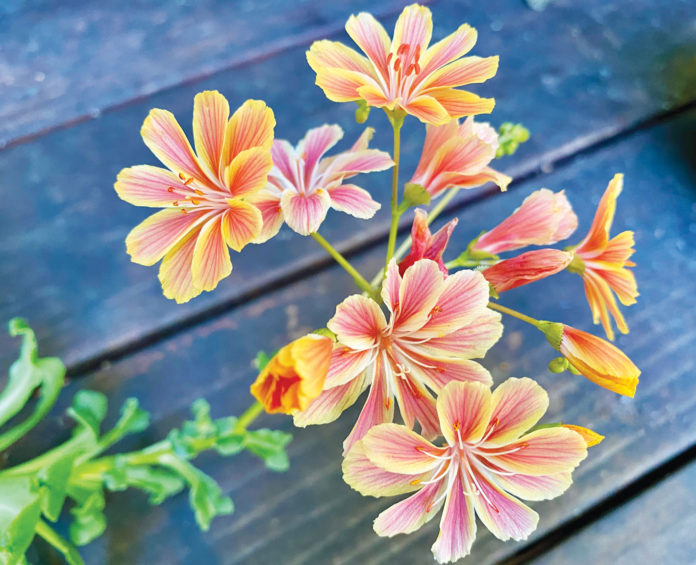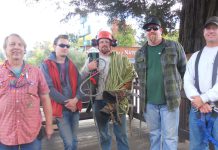I don’t grow corn in my small, shady garden, so I’m not sure how tall they’d be by now if I planted on May Day when the soil was 50 degrees, but that’s how the saying goes. And from what I’ve read about the early hot weather in the midwest, their corn is higher than knee high. But this column isn’t about growing corn, it’s about climate smart plants that hold up to the heat. So let’s get started.
All this talk about “drought tolerant” plants or “water smart” plants is misleading in some ways. What really matters for the success of a plant in your garden is that they are climate smart. You can call the new California garden climate tolerant or climate adapted, but it all comes down to the same thing. The plants you choose to grow in your garden should be able to naturally tolerate periods of lower than average water. This doesn’t mean no water during extremely long dry periods. No plant can live without water.
I have two books that I look to for plant ideas when called upon to design a garden in our area. This first was published by East Bay MUD in 2004 and is called “Plants and Landscapes for Summer-Dry Climates.” The other book I refer to regularly for ideas and information is “California Native Plants for the Garden.” Both are invaluable in these times of water conservation. One of the best tips each of them offer is to garden where you live.
All of us live in a summer-dry climate. Summer-dry gardens are naturally dry for long periods. Knowing which type of plant community you live in can make the difference between success and failure in your garden. Choose the right plant for the right place whether it’s a California native from an area with similar soil and exposure or a plant from another Mediterranean-like climate with growing conditions like yours.
Plant communities have evolved over time with geologic changes in climate, topography and soils. We have several district areas here—mixed evergreen forest, redwood forest, chaparral and sandhills.
If you live in a mixed evergreen forest you garden with trees like coast live oak, tan oak, madrone, bay and buckeye. Understory plants include ceanothus, coffeeberry, hazel and poison oak. Your soil contains serpentine and granite. Many other unthirsty plants like salvias, lavender, santolina, society garlic, giant feather grass, rosemary and rockrose do well here. California natives such as western mock orange (philadelphus lewisii), wild ginger and western sword ferns grow here also.
Mixed evergreen forest may also be found along canyon bottoms near streams where big leaf maple, white alder, cottonwood, and western sycamore trees grow. Most plants here grow lush in this deep soil. If you are looking to add something new to your garden here consider giant chain fern, aquilegia, dicentra, Pacific Coast iris and fuchsia-flowering gooseberry.
Chaparral areas are the hottest, driest slopes of these mountains. Dense thickets of manzanita, coyote brush, chamise, coffeeberry, ceanothus, monkey flower and sage are native here. These plants are adapted to little water and often have tiny, thick, waxy, light green or grayish leaves. Soils tend to be rocky and shallow with overlaying rock or a subsoil that is mostly clay.
Plants here need to have an extensive root system that reaches widely and deeply for water. If you live here, a classic combination would be the spring blooming western redbud and Julia Phelps or Dark Star ceanothus. The combination of magenta and electric blue flowers is unforgettable.
The sandhills near Quail Hollow and Bonny Doon around Martin Road are part of an ancient sandy sea floor that was uplifted, eroded and exposed. These sandy soils lack organic matter and nutrients and their white color magnifies the temperature of the summer sun. Unique, native plants like silverleaf manzanita and Ben Lomond wallflower live here. Buckwheat and sticky monkey flower do well here.
You might also try growing Siskiyou Lewisia, a pretty little plant native to northern California, thrives in sand and gravel soils with good drainage. This 8″ tall hardy perennial blooms from spring to early summer with extremely showy flower clusters in colors ranging from apricot to pink, rose and bright cherry red. Mulch them with gravel or crushed stone.
Remember, right plant-right place. Don’t try to force nature although most gardens do look better with some summer water. Closer to the house we expect a fuller look. Combinations I’m going to try this season include leucospermum paired with blue echium or grey-leafed westringia planted with red-flowering callistemon “Little John.”
Jan Nelson, a landscape designer and California-certified nursery professional, will answer questions about gardening in the Santa Cruz Mountains. Email her at ja******@*ol.com, or visit jannelsonlandscapedesign.com.












